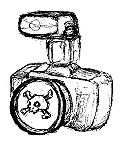![[ OPINIONS ]](/images/fall97/opinionsf97.gif)
![]()
Princess and paparazzi
![[photograph]](05_1_i.gif)
Katherine K. Gardiner |
By Katherine K. Gardiner
Arizona Daily Wildcat September 5, 1997
Charles and Diana were married on my birthday in 1981. I remember
her dress and the huge carriage carrying them through the streets of London.
The whole world knew Diana, and it wasn't because they shook her hand or
met her at a small cocktail party with London's elite. They, including myself,
knew her because the media provided the world with a princess. Their princess
could be seen on a 10-12 inch television screen, and her picture was plastered
on every periodical in the world. Now the world screams, "Death to
the paparazzi!"
It makes me wonder whether the general public knows the true difference between a photojournalist and a paparazzo. My guess would be no, judging from what Chip Hires, a photographer with a French agency, called a "witch hunt," while being interviewed by Knight-Ridder Newspapers on the attitude in Paris.
But it's not just Paris.
On Tuesday, a story came over The Associated Press wire about a female photojournalist in New Zealand being beaten by an angry crowd as she attempted to photograph an accident on a construction site. Someone in the crowd asked her whether she was getting a $1,000 for the shots.
An ABC correspondent in front of Buckingham Palace the day after the accident told Peter Jennings that windows had been broken in their TV news van, and that people were throwing rocks.
The dictionary says that a paparazzo (the singular of paparazzi) is a free-lance photographer who aggressively pursues celebrities for the purpose of taking candid photographs. The word was colloquialized from the main character in a Federico Fellini film, "La Dolce Vita" (1960). The film tells the story of a young journalist that has an aura about him as being a pest. The paparazzo itself as a parasite photographers first became common place with the other fairy tale story in history, the Kennedys'.
This is the difference between the scoop mongers who chased the princess that night and the photojournalists in the world. We see ourselves as ordinary people who photograph ordinary people who sometimes just happen to be famous. It's a job, not an obsession.
 That
night I would have taken pictures had I been there. I am a photojournalist.
That is what I do. But I'm a human first, and would have done everything
in my power to save her and the rest of the people in the car that night.
Or so I hope.
That
night I would have taken pictures had I been there. I am a photojournalist.
That is what I do. But I'm a human first, and would have done everything
in my power to save her and the rest of the people in the car that night.
Or so I hope.
I am by no means condoning anything that the seven photographers who chased the Mercedes did. No matter whether they consider themselves to be paparazzi or photojournalists, they behaved in an unprofessional and literally blood-hungry manner.
But before the world is so quick to judge on the moralities of the press, it must consider the purpose behind the whole concept of media.
The press are there to serve a market; a market of consumers who buy newspapers, magazines and tabloids that have curiosity peaking stories splattered across the top of the fold. The same finger of moral guilt behind her death can just as easily be pointed in the direction of her public who bought the trash. Dollar signs only speak of other dollar signs.
So the lesson here is what? Don't buy newspapers or watch TV shows playing upon sensationalism and peeping-tomism? Don't let journalists become so desensitized that they forget that a real person exists behind the image they portray?
I don't feel the lesson is anything quite so noble. The Mercedes was speeding in excess of 100 mph. The chauffeur had a blood alcohol level of 1.75 grams per liter, three times above the French sober limits, which is equivalent to 10 glasses of wine. There are eyewitness accounts of the Mercedes zigzagging through traffic and blatantly running a red light. Reports have even surfaced that the driver bragged to photographers prior to the chase that they wouldn't be able to catch him that night.
I remember a teacher once telling me about her experience when President Kennedy was assassinated in 1963. Being from Dallas, she speaks with a thick Texan drawl. In the days following the shooting, she said she would be in the grocery store and clerks would hear her accent and say, "Oh, you're from Texas." Even her fellow teachers with whom she worked in Phoenix treated her with animosity. She told me that she wanted to yell back at them, "I didn't personally kill the president!"
Watching the news the night of Princess Diana's accident, I became aware of what my teacher must have felt like. I am a photographer, therefore I must have killed one of the most loved women in the world.
Wrong. I live and work in a time where a picture speaks more than a thousand words. It speaks dollar signs, public demand, ethical questioning and much more than it used to. We might see an end of the tabloid era, but I doubt it. There are too many people who want to know the latest dish on their celebrity, or hear of the newest alien to give birth to two-headed twins.
Katherine K. Gardiner is the photo editor of the Daily Wildcat.



